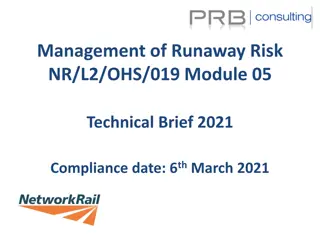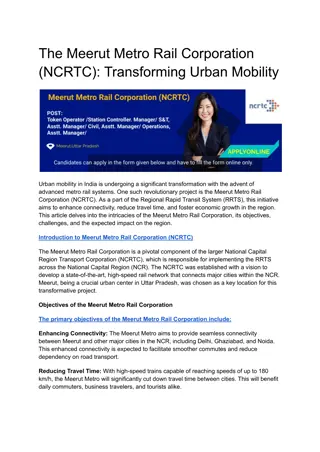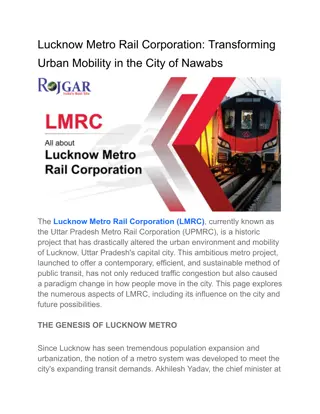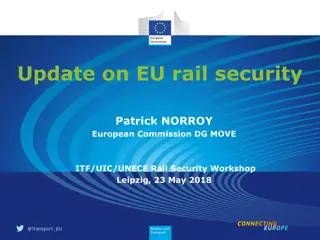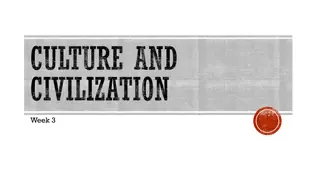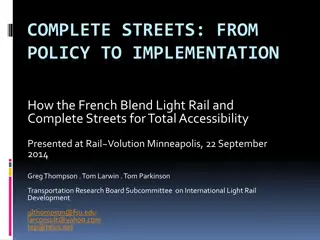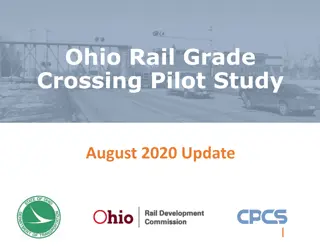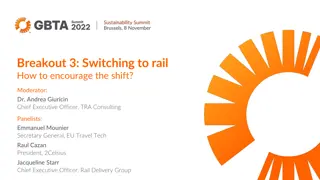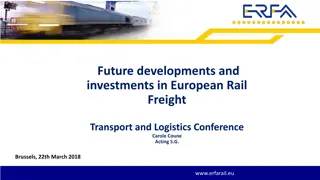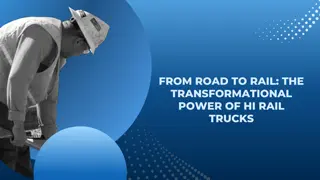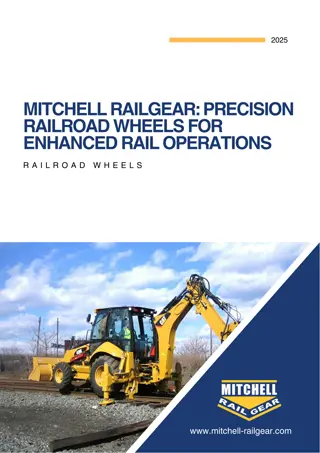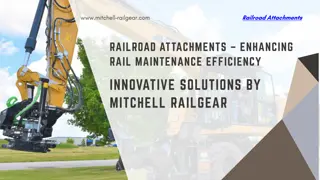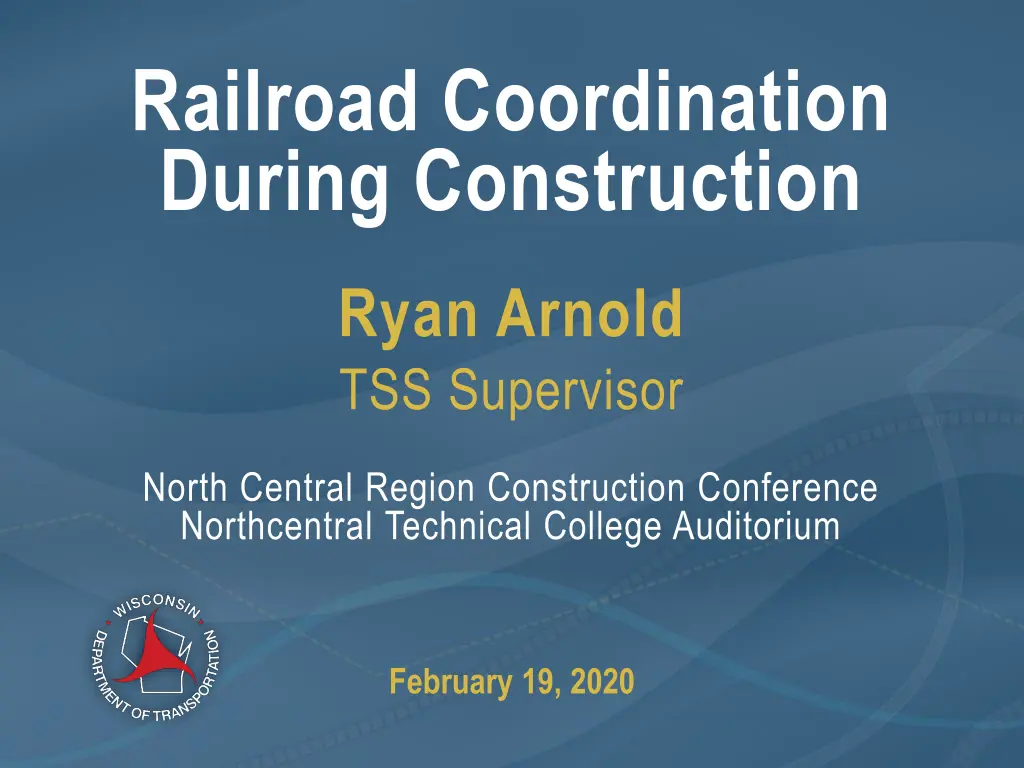
Railroad Construction Coordination Guidelines and Procedures
Discover essential guidelines and procedures for coordinating railroad construction, including meeting protocols, utility coordination, insurance requirements, schedule management, and contractor submittals. Ensure smooth collaboration between construction projects and railroad operations for successful outcomes.
Download Presentation

Please find below an Image/Link to download the presentation.
The content on the website is provided AS IS for your information and personal use only. It may not be sold, licensed, or shared on other websites without obtaining consent from the author. If you encounter any issues during the download, it is possible that the publisher has removed the file from their server.
You are allowed to download the files provided on this website for personal or commercial use, subject to the condition that they are used lawfully. All files are the property of their respective owners.
The content on the website is provided AS IS for your information and personal use only. It may not be sold, licensed, or shared on other websites without obtaining consent from the author.
E N D
Presentation Transcript
Railroad Coordination During Construction Ryan Arnold TSS Supervisor North Central Region Construction Conference Northcentral Technical College Auditorium February 19, 2020
Project Construction Leader (PCL) (or designated staff) Coordination Meet with the RRC prior to pre-con to discuss status of railroad coordination and standards. Keep RRC updated on railroad items, such as schedule, flagger, any contractor issues, utilities that affect the railroads work. Weekly meetings may be necessary. Railroad work is funded by the projects and is part of the project even though the work is being done by the railroad (similar to a subcontractor)
Project Construction Leader Utility Coordination Utilities should be relocated to ensure that they are not in conflict with the railroad signals, bungalow, etc. Utility relocations may be concurrent with construction and may need to be coordinated with the railroad work. Field coordinate with utility companies to ensure that there are no conflicts to the railroads work.
Railroad Insurance (RPLI) Railroad Protective Liability Insurance Do NOT issue the Start Notice prior to the railroad insurance being approved by the railroad. (Standard Provisions 107.17.3(6)) Ensure that if the construction project carries over to the following year that the railroad insurance is renewed before issuing the resume notice. If the railroad insurance expires during the construction project it must be renewed.
Schedule Contractor s Construction Schedule Invite the railroad to the Pre-construction meeting. Give ample notice to the railroad (14 days preferred). Contractor inform the railroad, RRC and PM/PL of current construction schedule and any changes to the schedule that affect the railroad work. Contractor should be in contact with the railroad to ensure the contractor and railroad schedules coincide.
Contractor Submittals Contractor s Construction Schedule Submit required documents to the railroad allowing enough time for review, objections and changes. Shop Drawings Shoring Plans/Excavation Plan (Roadway/Pipes) Structure Plans/Erection Plan Debris Containment Communication Plan Each railroad has their own timeline and requirements for submittals. It s the contractors responsibility to contact the RR representative to ensure the contractor knows these requirements.
Railroad Permits Additional Information Needed Contractor may be required to supply additional information to the railroad to complete the permit process prior to the railroad allowing the flagger to be scheduled and for the work to proceed. Permits to construct items such as culverts, storm sewer, sanitary sewer, water, electric, etc.
Railroad Flaggers PCL Responsibilities Know the Railroad s flagging requirements. If the contractor doesn t abide by the Railroad s flagging requirements Remove the contractor from the Railroad s property or completely shut the project down (CMM 2-25.3.3) Immediate communication with the RRC is necessary
Railroad Flaggers PCL Responsibilities PCL keep record of railroad flagger(s) on site for billing purposes if STSP 107-034 is in the Special Provisions Dates Time Staff (number of & names) When requested and cancelled Date & Time This documentation may be needed if there are any disputes regarding the flagging invoice. PCL review flagging invoice with RRC before submitting payment.
Railroad Flaggers Know the Railroad s Flagging Requirements Contractor communication is critical to understand when to clear the tracks, this allows the train to come through at timetable speed. The contractor will need to gain the flagman s trust. (How long does it take that contractor to clear the track). Some railroads contract out the flagging work, this may require the contractor to give a 45-day notice if a flagger is needed for more than 30 days. It s important for contractor to know the railroads flagging guidelines.
Railroad Flaggers Know the Railroad s Flagging Requirements Give minimum 24-hour notice if cancelling the railroad flagger otherwise will be charged for flagger. Cranes require flagging when the boom length measured toward the track is closer than 25 . (flagging see CMM 2-58.3.3) Flagging is needed until the forms are stripped from the parapets .
Railroad Flaggers Know the Railroad s Flagging Requirements Flaggers can t extend the work block beyond what is requested by the contractor. Ensure that enough time is requested or the flagger will be required to leave and construction near the railroad will halt.
Call Before You Dig Each RR has their own CBYD number Railroads are NOT part of Digges Hotline. See the RR STSP for Railroad Call Before Your Dig number.
Contractor Orientation/E-Rail Safe If Required per RR STSP Contractor Orientation/E-Rail Safe training and badges are required for all contractor staff and subcontractors that will be working on RR R/W. WisDOT staff is not required, nor can WisDOT staff take the Contractor Orientation/E-Rail Safe training due to indemnification language in the training. Consultants working for WisDOT are not required to take the training but can if they choose to.
Personal Protective Equipment PPE s Ensure that ALL PPE s are worn when working on railroad right-of-way. Hard Hat Safety Vest Steel Toe Boots Safety Glasses Hearing Protection (train horns 120 decimals) Railroad will remove you from their property if not worn.
Construction Safety Near Railroad Mistakes Can Be Deadly Railroad may shut the project down if rules are not followed, if this happens PCL shall contact the RRC immediately. Anna Davey 715-392-7960 Jared Kinziger 920-492-7713
Survey and Inspection During Construction Staking and inspecting (by project staff) needed to ensure proper locations and elevations of railroad signal and crossing surface. If the railroad installs the signals or crossing surface in the wrong location or elevation, it may require extending closures, delays and cost to the project. It is better to ensure that it is done correctly the first time than trying to get the railroad to come back to reinstall it.
Paving Paving Up To Crossing Surface Utilize the SDD(s) and plan . Prior to paving, discuss specific paving requirements with the RRC.
Plan Changes Involving the Area Near the Railroad Do not make changes in the field to the center median, sidewalk etc. at or near an at-grade railroad crossing without consulting with the RRC first.
Access Issues Involving the Area Near the Railroad Ensure the railroad has access to the work area and room to work. Example, a paving contractor place stakes in the same location that the railroad needed to excavate to place railroad signals. This delayed the railroad about a day which cost WisDOT approximately $4,000.
Drainage and Restoration Railroad Property Leave it better than when you got there. Can t negatively affect railroad property. Keep the area near the railroad clear of debris and piles. Ensure that NO fine graded material (sand/topsoil) get place on top of the ballast or railroad ditches. This include through erosion. Keep the railroad flangeways clean.
Any Questions or Issues During Construction Contact the RRC If you can t get in contact with the RRC responsible for railroad coordination on a project please leave a message and contact the other RRC if it cannot wait for a response back. Anna Davey 715-392-7960 Jared Kinziger 920-492-7713


